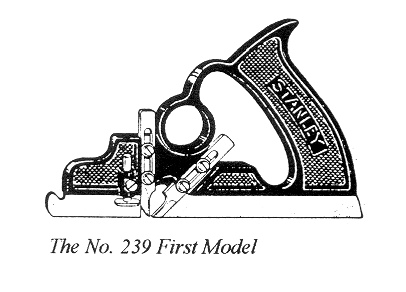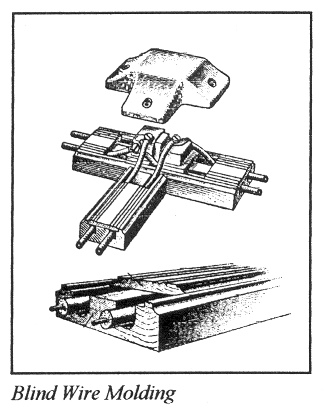|
The 239 and how it worked
- A narrow 1/8 inch wide plow cutter projected through a thin deep skate that
allowed cutting grooves up to 1/2 inch deep.
- A depth stop controlled the depth of cut and a vertical double spur cutter in
front of the plow cutter was sharpened to score the fibers of the wood on each
side of the cut when plowing grooves across the grain.
- The plane had a forward tilted iron handle and a circular ring for the index
finger. This made the plane easy to use and allowed it to be controlled with one
hand.
The 1915 Catalogue listed the No. 239 Special Dado Plane in the same group with
the No. 39 series of Iron Dado Planes.
- The 1/8 inch wide cutter of the No. 239 extended the choice of dado
widths provided by Stanley Iron Dado Planes to range from 1/8 inch to 1 inch
by 1/8 inch increments.
- The early version of the No. 239 (like all the other planes in the No. 39
series of Iron Dado Planes) did not have a fence.
In 1919, Stanley offered a second version of the Special Dado Plane. It was
called the No. 239 1/2 Improved Dado Plane.
The 239 1/2 and how it worked
- The No. 239 1/2 was intended primarily for plowing grooves parallel to the
grain.
- It had a fence the same length as the skate which made it convenient to use for
plowing grooves parallel to the long edge of a wood molding.
- Since the plane
was not intended for cross grain work, the casting was not machined to
accommodate the vertical double spur cutter.
- It was interesting that Stanley Catalogues of the period did not
illustrate or describe the No. 239 1/2 as being without the double
spur cutter for cross grain work.
A Description of the 239 1/2
- The body casting was not milled out to receive the vertical double spur
cutter.
- A long fence was mounted on a pair of arms identical to those used on
the No. 78 Rabbit Plane.
- The Box Label had a small supplemental label imprinted "1/2" pasted at
the end of "No. 239".
- The No. 239 1/2 was offered for only four years ( 1919 to 1923) which
accounts for it's relative scarcity.
The End of the 239 1/2
The No. 239 1/2 was dropped from the line in 1923. Existing stock was
probably sold by the time the fence was added to the No. 239.
The 239 Addition
In 1925, a fence was added to the No. 239.
- The fence adapted the 239 for cutting grooves both parallel to and
across the grain.
- This change made it unnecessary for workmen to carry two similar planes
and saved retailers the expense of stocking both of them.
In 1926 and later, the No. 239 was offered in 1/8 inch, 3/16 inch or 1/4
inch widths. In 1929, the option of a 5/32 inch width was added and the
1/4 inch width was discontinued.
Experimental Models of the 239
An experimental model of the No. 239 is illustrated in figure 385 on
page 243 of Patented Transitional and Metallic Planes in America, Volume
II by Roger K. Smith.
Another interesting experimental variation of the No. 239 is illustrated
in the opposite photo and in the March 1995 issue of The Gristmill
Magazine published by the Mid-West Tool Collectors Association. This
variation plowed a 1/16 inch wide groove and had a small skew cutter
mounted in an L-shaped bed at the top of the plane to provide a 90
degree trim function.
-John Wells has been a member of PAST for many years. He and his
wife, Janet sell tools under the name Grizzly Antiques (see back page
ad). John and PAST member, Jack Schoellhamer have recently written a
major two-part article for The Gristmill on "Bailey's Excelsior Block
Plane ". The articles appear in the June and September 1996 issues.
-For further information on PAST member Roger K. Smith's book, Patented
Transitional and Metallic Planes in America. contact:
Roger K. Smith.
Box 177. Athol, MA 01331
|
 The Stanley No. 239 Special Dado Plane was covered by Christian Bodmer's
March 30, 1915 Patent No.
1,134,072. It was assigned The No. 239 First Model to the Stanley Rule and Level
Co. The patent drawing illustrated the plane exactly as it was offered in the
1915 Stanley No. 34 Catalogue.
The Stanley No. 239 Special Dado Plane was covered by Christian Bodmer's
March 30, 1915 Patent No.
1,134,072. It was assigned The No. 239 First Model to the Stanley Rule and Level
Co. The patent drawing illustrated the plane exactly as it was offered in the
1915 Stanley No. 34 Catalogue.

